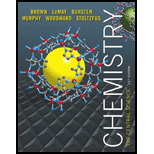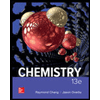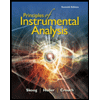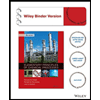
Chemistry: The Central Science (13th Edition)
13th Edition
ISBN: 9780321910417
Author: Theodore E. Brown, H. Eugene LeMay, Bruce E. Bursten, Catherine Murphy, Patrick Woodward, Matthew E. Stoltzfus
Publisher: PEARSON
expand_more
expand_more
format_list_bulleted
Question
Chapter 5, Problem 95AE
(a)
Interpretation Introduction
To determine:
If work is performed during the given expansion of gas.
(b)
Interpretation Introduction
To determine:
The explanation on work not being done in the given expansion process.
(c)
Interpretation Introduction
To determine:
If it is possible to determine the value of
Expert Solution & Answer
Want to see the full answer?
Check out a sample textbook solution
Chapter 5 Solutions
Chemistry: The Central Science (13th Edition)
Ch. 5.2 - Prob. 5.1.1PECh. 5.2 - Prob. 5.1.2PECh. 5.3 - Prob. 5.2.1PECh. 5.3 - Prob. 5.2.2PECh. 5.3 - Prob. 5.3.1PECh. 5.3 - Prob. 5.3.2PECh. 5.4 - Prob. 5.4.1PECh. 5.4 - Prob. 5.4.2PECh. 5.5 - Prob. 5.5.1PECh. 5.5 - Prob. 5.5.2PE
Ch. 5.5 - Practice Exercise 1 Suppose you have equal masses...Ch. 5.5 - Prob. 5.6.2PECh. 5.5 - Prob. 5.7.1PECh. 5.5 - Prob. 5.7.2PECh. 5.6 - Prob. 5.8.1PECh. 5.6 - Prob. 5.8.2PECh. 5.6 - Prob. 5.9.1PECh. 5.6 - Prob. 5.9.2PECh. 5.7 - Prob. 5.10.1PECh. 5.7 - Prob. 5.10.2PECh. 5.7 - Prob. 5.11.1PECh. 5.7 - Prob. 5.11.2PECh. 5.7 - Prob. 5.12.1PECh. 5.7 - Practice Exercise 2 Use Table 5.3 to calculate the...Ch. 5.8 - Prob. 5.13.1PECh. 5.8 - Practice Exercise 2 Given the following standard...Ch. 5.8 - Prob. 5.14.1PECh. 5.8 - Prob. 5.14.2PECh. 5 - Prob. 1DECh. 5 - Prob. 1ECh. 5 - Prob. 2ECh. 5 - Prob. 3ECh. 5 - Practice Exercise 2
Using Table 20.1, rank...Ch. 5 - Prob. 5ECh. 5 - Prob. 6ECh. 5 - Prob. 7ECh. 5 - Prob. 8ECh. 5 - Prob. 9ECh. 5 - Prob. 10ECh. 5 - Prob. 11ECh. 5 - Prob. 12ECh. 5 - Prob. 13ECh. 5 - Prob. 14ECh. 5 - Prob. 15ECh. 5 - Prob. 16ECh. 5 - Prob. 17ECh. 5 - Prob. 18ECh. 5 - Prob. 19ECh. 5 - Prob. 20ECh. 5 - Prob. 21ECh. 5 - Prob. 22ECh. 5 - Prob. 23ECh. 5 - Prob. 24ECh. 5 - Prob. 25ECh. 5 - Prob. 26ECh. 5 - Prob. 27ECh. 5 - In chemical kinetics, the entropy of activation is...Ch. 5 - Prob. 29ECh. 5 - Prob. 30ECh. 5 - Prob. 31ECh. 5 - The following data compare the standard enthalpies...Ch. 5 - Prob. 33ECh. 5 - Prob. 34ECh. 5 - Prob. 35ECh. 5 - What is the reducing agent in the following...Ch. 5 - Prob. 37ECh. 5 - Prob. 38ECh. 5 - Prob. 39ECh. 5 - Prob. 40ECh. 5 - Prob. 41ECh. 5 - Prob. 42ECh. 5 - Prob. 43ECh. 5 - The standard cell potential is 1.46 V for a...Ch. 5 - Prob. 45ECh. 5 - Prob. 46ECh. 5 - Prob. 47ECh. 5 - Prob. 48ECh. 5 - Prob. 49ECh. 5 - Practice Exercise 1
Which of the following...Ch. 5 - Prob. 51ECh. 5 - Prob. 52ECh. 5 - Prob. 53ECh. 5 - Prob. 54ECh. 5 - Prob. 55ECh. 5 - Prob. 56ECh. 5 - Prob. 57ECh. 5 - Prob. 58ECh. 5 - Prob. 59ECh. 5 - Prob. 60ECh. 5 - What is the connection between Hess’s law and the...Ch. 5 - Prob. 62ECh. 5 - 20.2 You may have heard that “antioxidants” are...Ch. 5 - Prob. 64ECh. 5 - Prob. 65ECh. 5 - Prob. 66ECh. 5 - Prob. 67ECh. 5 - Prob. 68ECh. 5 - Prob. 69ECh. 5 - Prob. 70ECh. 5 - Prob. 71ECh. 5 - Prob. 72ECh. 5 - 20.13
What is meant by the term oxidation?
On...Ch. 5 - Prob. 74ECh. 5 - Prob. 75ECh. 5 - Prob. 76ECh. 5 - Prob. 77ECh. 5 - Prob. 78ECh. 5 - Prob. 79ECh. 5 - Prob. 80ECh. 5 - Prob. 81ECh. 5 - Prob. 82ECh. 5 - Prob. 83ECh. 5 - Prob. 84ECh. 5 - Prob. 85ECh. 5 - The heat of combustion of ethanol, C2H5OH(l) is...Ch. 5 - Prob. 87ECh. 5 - Prob. 88ECh. 5 - Prob. 89ECh. 5 - The automobile fuel called E85 consists of 85%...Ch. 5 - Prob. 91AECh. 5 - Prob. 92AECh. 5 - Prob. 93AECh. 5 - Prob. 94AECh. 5 - 5.95 Consider a system consisting of the following...Ch. 5 - A sample of gas is contained in a...Ch. 5 - Prob. 97AECh. 5 - Prob. 98AECh. 5 - A house is designed to have passive solar energy...Ch. 5 - Prob. 100AECh. 5 - Prob. 101AECh. 5 - Prob. 102AECh. 5 - Burning methane in oxygen can produce three...Ch. 5 - Prob. 104AECh. 5 - Prob. 105AECh. 5 - The hydrocarbons acetylene (C2H2) and benzene...Ch. 5 - Prob. 107AECh. 5 - Three common hydrocarbons that contain four...Ch. 5 - Prob. 109AECh. 5 - The Sun supplies about 1.0 kilowatt of energy for...Ch. 5 - It is estimated that the net amount of carbon...Ch. 5 - Prob. 112IECh. 5 - Prob. 113IECh. 5 - Prob. 114IECh. 5 - Prob. 115IECh. 5 - Prob. 116IECh. 5 - Prob. 117IECh. 5 - The methane molecule, CH4, has the geometry shown...Ch. 5 - Prob. 119IE
Knowledge Booster
Learn more about
Need a deep-dive on the concept behind this application? Look no further. Learn more about this topic, chemistry and related others by exploring similar questions and additional content below.Recommended textbooks for you
 ChemistryChemistryISBN:9781305957404Author:Steven S. Zumdahl, Susan A. Zumdahl, Donald J. DeCostePublisher:Cengage Learning
ChemistryChemistryISBN:9781305957404Author:Steven S. Zumdahl, Susan A. Zumdahl, Donald J. DeCostePublisher:Cengage Learning ChemistryChemistryISBN:9781259911156Author:Raymond Chang Dr., Jason Overby ProfessorPublisher:McGraw-Hill Education
ChemistryChemistryISBN:9781259911156Author:Raymond Chang Dr., Jason Overby ProfessorPublisher:McGraw-Hill Education Principles of Instrumental AnalysisChemistryISBN:9781305577213Author:Douglas A. Skoog, F. James Holler, Stanley R. CrouchPublisher:Cengage Learning
Principles of Instrumental AnalysisChemistryISBN:9781305577213Author:Douglas A. Skoog, F. James Holler, Stanley R. CrouchPublisher:Cengage Learning Organic ChemistryChemistryISBN:9780078021558Author:Janice Gorzynski Smith Dr.Publisher:McGraw-Hill Education
Organic ChemistryChemistryISBN:9780078021558Author:Janice Gorzynski Smith Dr.Publisher:McGraw-Hill Education Chemistry: Principles and ReactionsChemistryISBN:9781305079373Author:William L. Masterton, Cecile N. HurleyPublisher:Cengage Learning
Chemistry: Principles and ReactionsChemistryISBN:9781305079373Author:William L. Masterton, Cecile N. HurleyPublisher:Cengage Learning Elementary Principles of Chemical Processes, Bind...ChemistryISBN:9781118431221Author:Richard M. Felder, Ronald W. Rousseau, Lisa G. BullardPublisher:WILEY
Elementary Principles of Chemical Processes, Bind...ChemistryISBN:9781118431221Author:Richard M. Felder, Ronald W. Rousseau, Lisa G. BullardPublisher:WILEY

Chemistry
Chemistry
ISBN:9781305957404
Author:Steven S. Zumdahl, Susan A. Zumdahl, Donald J. DeCoste
Publisher:Cengage Learning

Chemistry
Chemistry
ISBN:9781259911156
Author:Raymond Chang Dr., Jason Overby Professor
Publisher:McGraw-Hill Education

Principles of Instrumental Analysis
Chemistry
ISBN:9781305577213
Author:Douglas A. Skoog, F. James Holler, Stanley R. Crouch
Publisher:Cengage Learning

Organic Chemistry
Chemistry
ISBN:9780078021558
Author:Janice Gorzynski Smith Dr.
Publisher:McGraw-Hill Education

Chemistry: Principles and Reactions
Chemistry
ISBN:9781305079373
Author:William L. Masterton, Cecile N. Hurley
Publisher:Cengage Learning

Elementary Principles of Chemical Processes, Bind...
Chemistry
ISBN:9781118431221
Author:Richard M. Felder, Ronald W. Rousseau, Lisa G. Bullard
Publisher:WILEY
The Laws of Thermodynamics, Entropy, and Gibbs Free Energy; Author: Professor Dave Explains;https://www.youtube.com/watch?v=8N1BxHgsoOw;License: Standard YouTube License, CC-BY